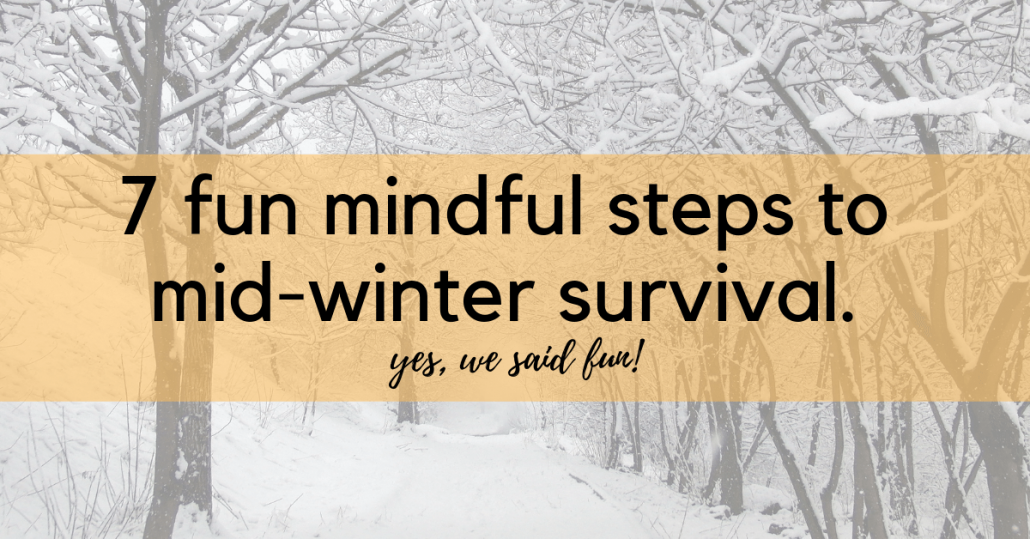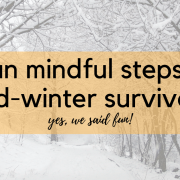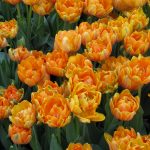Yes, we said fun!
It is the end of February and nearly everyone I know has had enough of winter! Sadly, there is still possibly two more months of snow, slush, dark days, and cold winds. There are many reasons the winter months can have such an impact on our well-being. We’ve put together this 7-step fun mindfulness based mid-winter survival guide to help you make the most of the (hopefully short) season.
The steps below include many informal mindfulness practices. Informal mindfulness is about doing one thing at a time, with full awareness. Anything can be become a mindfulness practice. All you have to do is to pause, take a few breaths, and observe through your five senses what is happening. Yes, your mind will distract you. Simple notice this and return your attention back to the task.

1. Because I’m happy
Happy music makes you feel happy and research proves it. Listening to uplifting music may be an effective way to improve happiness, especially when it is combined with an intention to become happier (Ferguson & Sheldon, 2012). So sing in the shower, sing to your children or pets, and dance around the living room.
- Mindful Moment: Pick a song that makes you feel happy. Close your eyes and tune into the sounds, notice how the music enters your ears, what instruments you hear? How does it feel in your body. Do you notice the smile coming to your face or your feet beginning to tap? Try listening to one song (or even a part of a song) mindfully everyday.
2. Stay cozy
Have you heard of hygge? It is the Danish art of happiness, which roughly translates to feelings of coziness and contentment. The Danish survive their winter days by creating a warm atmosphere through the pleasures of simpler things. Such as, enjoying a cup of coffee or cocoa with a friend, lighting candles and cuddling with a warm blanket, wearing wooly slippers and puttering around, reading a book by the fire, or baking bread. These are all great examples of informal mindfulness practices.
- Mindful Moment: Try taking one mindful sip of your favorite hot beverage. Feel the cup in your hand, notice the steam, does it have a smell? When your mind distracts you (and it will) bring it back to the experience. Try to feel the anticipation as you bring the cup to your lips. Notice how your mouth responds as it welcomes the taste. Try to make the conscious choice of when you swallow.
3. Do something fun
Starting a hobby is another way to put some pep in your snowy step. As you might already be stuck inside why not make a top ten list (we really like lists) of books to read or movies to watch. In Ottawa, we are so lucky to be bursting with creative outlet options, such as taking an art class or woodworking course. For example, I recently attended a sour dough workshop. Now my mind is busy researching recipes, filling the house with delicious smells, and not to mention the warmth that comes from a hot oven. Keep in mind, it doesn’t’ t have to cost money. Youtube is also a great source for learning just about anything.
- Mindful Moment: Think about choosing an activity that brings you joy. During this process notice what happens when you start deciding on what you want to do. Is your mind telling you, “there are more important things that need to get done,” or “you are no artist.” When this happens try to stay neutral by simply thanking your mind and returning to the task at hand gently and kindly. It may help to write down potential activities and then beside them write why you enjoy this activity.
4. Plan something
A home project or even planning a trip is another way to increase your winter wellness. This can help to feel accomplished or have something to look forward to. In our house, the new year started by using Marie Kondo’s Magical Art of Tidying Up techniques to declutter and organize just about everything. It took us all of January but it helped to distract from the post-holiday blues and in the end we felt more at ease! We highly recommend the book or the series on Netflix. Alternatively, planning a trip for the future can also elevate the spirits. One study that looked at vacationers before and after trips found that vacationers rated happier prior to the trip than after. This may be attributed to the feelings of anticipation that come with waiting for a holiday (Nawijn, Marchand, Veenhoven & Vingerhoets, 2010).
- Mindful Moment: Try to mindfully fold your clothes (or even one clothing item) the next time you do laundry. Pause to notice the textures and patterns of the clothing in the hamper. Notice your arm as you select an item to fold. Notice how your arm reaches out, grasps, and places the clothing item down. Feel the texture beneath your hands as you smooth the surface and begin to fold. Marie Kondo has this great video to demonstrate folding with intention.
5. Mind your mind
For some winter can evoke a sense of hibernation. The natural world is frozen and almost everything seems to be moving slower. It’s almost as if the season is suggesting to take this time to turn inwards, pay attention to your body, slow your breathing and just pause. Practices like yoga and mindfulness are widely recognized to ease stress, help regulate emotions, and increase overall wellbeing and longevity (Dahlgaard, Jørgensen, Majvan, et al., 2018). One resource to start (or restart) your meditation practice is an app called insight timer. It contains guided meditations alongside a real sense of global community.
- Mindful Moment: Bmindful will be offering a half-day Introduction to Mindfulness workshop in early April. This course will help you gain an understanding of mindfulness, clarify misconceptions, gain skills to change automatic reactions (habits), and an opportunity to practice both formal and informal mindfulness techniques.
6. Get outside!
Going for a walk when the temperatures are below freezing is not the easiest thing, we know. However, the benefits are worth it. Spending time outside can improve focus and lower stress levels (Hahn, Grynderup, Dalsgaard et al., 2011). So bundle up, put on a good podcast or audio book and get out there. One thing I like to do is pre-boil the teakettle so I can warm up quickly upon return.
- Mindful Moment: When you make the decision to go outside take a brief pause. Notice your thoughts surrounding leaving the house. What is your mind saying? Does it say “brrrr it looks freezing,” or “I hate winter.” Notice what happens in your body as you think about leaving. Does your back stiffen or shoulders slouch? Try your best to acknowledge the thoughts as just thoughts. Say to yourself “I’m noticing, I am having the thought…(insert thought).” This will help to move from a place of being tangled in the thoughts to a place of awareness. Ultimately you get to decide if you choose to believe this thought or not. Perhaps you will notice it is not serving you well.
7. You are my sunshine
The days are darker longer. Even with the sun setting later and later every day, it is still usually dark by 6:00pm. Most days you may find yourself leaving before the sun rises and coming home once it is already set. Some evidence-based forms of light therapy to counter the negative impact of these dark days include taking Vitamin D supplements, sitting in front of a light box daily, or using a dawn simulator to wake up.
Vitamin D: This vitamin is known as the “sunshine” vitamin, because our major source of it comes from the sun. It is widely recognize that the winter months may lead to a deficiency of this vitamin in the body. Taking a Vitamin D supplement is one easy way to counter this affect (Nair & Maseeh, 2012).
Light Box: A light box can mimic the sun by radiating the full-spectrum light of 10,000 lux. Sitting in front of one of these for 20-60 minutes daily has been found to reduce SAD symptoms (Golden, Gaynes, Ekstrom et al., 2005). It is recommended to experiment with the time-range of light, as too much light may disrupt your natural circadian rhythm
Dawn Simulators: These are devices that cause the lights in your bedroom to gradually brighten over a set period of time. Some studies have demonstrated it can help restore the body’s regular rhythm of waking and sleeping. This form of light therapy has also been found to reduce depression symptoms (Golden, Gaynes, Ekstrom et al., 2005).
- Mindful Moment: The next time you notice a ray of sunshine beaming in through the window give yourself permission to pause. Even if it feels silly, encourage yourself to sit within ray of sun. Close your eyes. Notice the feeling of sun on your skin. Does it feel warm? What happens to other parts of your body as your body temperature rises slightly? Try to take three slow breaths.
By the way
No you don’t have to do everything on the list to feel better! However, trying at least two may definitely ease the remaining winter days. Good luck, and may the warmth be with you!
References:
Dahlgaard J, MunkJørgensen M, Majvan der Velden A, Sumbundu A, Gregersen N, Olsen R., K, YungMehlsen M (2018). Mindfulness, Health, and Longevity. The Science of Hormesis in Health and Longevity. 22, 243-255.
Hahn I. H, Grynderup M. B, Dalsgaard S. B, Thomsen J. F, Hansen Å. M, Kærgaard A, Kærlev L, Mors O, Rugulies R, Mikkelsen S, Bonde J. P, & Kolstad HA (2011). Does outdoor work during the winter season protect against depression and mood difficulties? Scandinavian Journal of Work, Environment & Health. 37 (5).
Golden N. B.,, Gaynes N., R, Ekstrom R. D, Hamer, M. R, Jacobsen M. F, Suppes T, Wisner L. K, & Nemeroff, C (2005). The Efficacy of Light Therapy in the Treatment of Mood Disorders: A Review and Meta-Analysis of the Evidence. American Journal of Psychiatry. (4)162, 656-662.
Nair, R., & Maseeh, A. (2012). Vitamin D: The “sunshine” vitamin. Journal of pharmacology & pharmacotherapeutics, 3(2), 118-26.
Nawijn, J., Marchand, M.A., Veenhoven, R. et al. (2010) Vacationers Happier, but Most not Happier After a Holiday. Applied Research Quality Life (5) 35.
Yuna L. Ferguson & Kennon M. Sheldon (2013) Trying to be happier really can work: Two experimental studies, The Journal of Positive Psychology, (8)1, 23-33.


